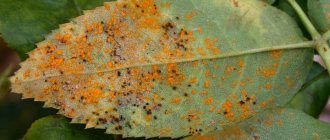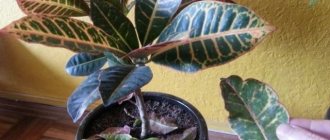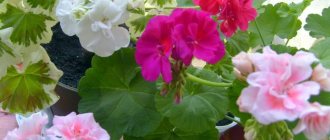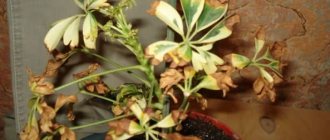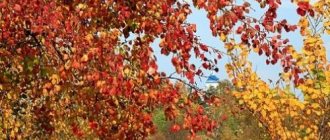Everyone knows that the rose is a gorgeous flower and is rightfully called the “Queen of the Garden.” But unfortunately, we often observe that the leaves of this flower turn yellow.
If this process occurs in the fall, do not worry, this is normal, natural aging and preparation for winter are taking place, the rose sheds its leaves.
You should be wary and pay attention if the rose turns yellow in the summer, when it should bloom and decorate the flower beds.
Next, we’ll look at the reasons why rose leaves turn yellow and fall off: what to do, how to feed and treat the beautiful flower.
Lack of batteries
Yellowing of roses is often associated with a lack of nutrients. The main elements that roses need are:
- Macroelements: nitrogen; potassium; phosphorus.
- Microelements: iron; magnesium; manganese.
If there is a deficiency of one of these basic elements, you can observe: Yellowing of leaves from the edges, completely, in spots.
The site already has an article Feeding roses in spring: how and what is best to fertilize for lush and long-lasting flowering
Lack of macroelements: nitrogen and potassium
| Lack of element | What leaves look like | Signs | How to treat |
| nitrogen | Young leaves become smaller, become pale green, and fall off prematurely. Sometimes red spots appear on them. The stems become bent and weaken. | Use Urea (urea), ammonium nitrate, complex fertilizer: Superphosphate, Potassium Sulfate | |
| potassium | Young leaves are reddish, mature leaves are green with brown, dry edges. The flowers are getting smaller. Potassium deficiency is observed in sandy soils. | Apply complex fertilizer: Superphosphate, potassium sulfate, potassium magnesia, potassium humate | |
| phosphorus | Young leaves become smaller, reddish-purple below, and fall off. The stems bend and weaken. | Apply complex fertilizer: Superphosphate, Potassium sulfate |
Nitrogen
In case of nitrogen deficiency, rose leaves first turn pale, turn completely yellow, and then fall off. Young shoots stop developing. As a rule, the reason for this is planting in nitrogen-poor soil. Immediately you need to carry out nitrogen root feeding.
Important! First, you need to water the rose with clean water.
Nitrogen fertilizing options:
- Urea (carbamide). Prepare an aqueous solution of 2 tbsp. spoons per bucket of water 10 liters.
- Ammonium nitrate (potassium nitrate) .Take 2 tbsp. spoons of fertilizer in a bucket of water. Water 2-3 liters at the root for each bush.
- Cow dung. Infuse 1 kg of manure in 10 liters of water for a week. Dilute 1:10 with water and water 2-3 liters for each flower.
- Bird droppings . Also infuse 1 kg of litter in 10 liters of water for a week, dilute 1:20 and water.
- Green herbal infusion. (2-3 containers of cut nettles and other herbs are filled with water to the brim, left for 7 days, stirring occasionally, watered with a solution of 1 liter of infusion per 10 liters of water.)
Potassium
With a lack of potassium, the lower leaves begin to turn yellow along the edges. The inside of the leaf remains green. Young leaves are reddish in color.
Immediately need to be fed with potassium supplements:
- The simplest potassium supplement is wood ash (potassium + microelements). Pour 2-3 handfuls of ash into the tree trunk circle and loosen the soil.
- Potassium sulfate (potassium sulfate) 2 tbsp. spoons per 10 liters of water or also 2 tbsp. scatter spoons into a circle around the trunk and loosen;
- Potassium nitrate (potassium + nitrogen), feed in a concentration similar to the above;
- Calimagnesia (potassium + magnesium), also 2 tbsp. spoons per 10 liters of water or dry in a circle around the trunk;
- Potassium humate (potassium + microelements), for example, Humate concentration +7 - 1 ampoule per 200 liters of water.
Phosphorus
Phosphorus deficiency manifests itself in redness of the lower leaves. The top ones become small.
Nitrogen and potassium deficiency
Most often, leaves turn yellow precisely due to a lack of nitrogen. To understand this, pay attention to the following signs:
- Mainly the lower leaves turn yellow;
- the upper foliage becomes small and weak;
- the bush produces fewer and fewer new buds.
If all these signs are present, feed the bush with nitrogen-containing fertilizer. Potassium deficiency is most often manifested by the following symptoms:
- leaves turn yellow from the edge to the center;
- sometimes the leaves begin to turn red and then completely turn black.
This problem can be corrected in the same way as nitrogen deficiency by feeding the plant with potassium fertilizer.
Lack of microelements: iron, magnesium, manganese
| Lack of element | What leaves look like | Signs | How to treat |
| magnesium | The middle of the leaf is pale, the tissue dies near the central vein. It appears more on older leaves. Leaves fall prematurely. | Use magnesium sulfate (magnesium sulfate) | |
| iron | It is especially noticeable on young leaves. The leaves turn yellow. reddish, adults - green with brown dried edges. The flowers are getting smaller. Potassium deficiency is observed in sandy soils. | Reduce lime content in the soil. Apply complex fertilizer: Ferovit, you can try iron sulfate. MultiTonic, Toprose | |
| manganese | More noticeable on older leaves. Yellow stripes between the veins on the leaves. | Reduce lime content in the soil. Fertilizer MultiTonic, Manganese sulfate. |
Magnesium
With a lack of magnesium, the middle of the leaf turns yellow, reddish spots appear, and the edges remain green. Yellowing occurs first on the lower old leaves, then rises higher.
It is worth using as a supplement
- magnesium sulfate (magnesium sulfate);
- 2 tbsp. spoons into a bucket of water.
Iron
Often rose leaves turn yellow due to iron deficiency, which leads to chlorosis of the young upper leaves of the flower. The entire leaf turns yellow, the veins remain green. Iron deficiency can be compensated by:
Ferovit 1 ampoule per 1.5 liters of water. Spray.
By the way! Some advise using iron sulfate. At the same time, you will also carry out antimicrobial treatment.
Read more in our article Using iron sulfate in gardening in autumn and spring: when and how to process, instructions for use .
Manganese
Manganese deficiency manifests itself in damage to the lower old leaves, which turn yellow from the edges to the middle of the leaf, while the veins remain green.
Feeding:
- manganese sulfate;
- 2 tbsp. spoons into a bucket of water.
Important! Deficiency of iron and manganese is observed in alkaline soil conditions (pH above 7); it is necessary to bring the soil to a normal and slightly acidic reaction pH of 5-7. This can be achieved by mulching the roses with pine needles or peat.
Waterlogging or drying out of the soil
If the watering regime is incorrect, yellowing and premature loss of rose bush foliage can also occur. If there is too much liquid, the root system of the plant will begin to rot. If there is a lack of moisture, roses simply do not have enough nutrients for normal development and growth.
How often you need to water your roses depends on several factors. Firstly, it is important in what soil the flower grows. Sandy soil requires more frequent watering, clay soil requires less frequent watering. Secondly, the weather is important. The higher the temperature, the more moisture rose bushes require. In cloudy and cool weather, watering should be done as little as possible. To understand whether watering is needed right now, carefully drip the soil 3-5 cm deep and try to squeeze a handful of soil in your hand: if it gathers into a dense lump, there is enough moisture, if it crumbles, it’s time to water.
Improper watering
Roses require moderate watering. Overmoistening of the soil leads to oxygen starvation. The leaves below begin to turn yellow, the entire leaf blade becomes yellow.
Watering should be reduced. And if roses are planted in heavy clay soil, replant them with drier and lighter soil.
Perhaps, on the contrary, your rose does not have enough humidity and watering is insufficient, the leaves turn yellow, curl and fall off.
In this case, you need to increase the frequency and volume of watering and mulch the tree trunk circle to prevent the soil from drying out.
Pest infestation
Most often, gardeners encounter these pests:
- ilya;
- thrips;
- rose leafhopper;
- spider mite
All these pests lead to yellowing of the foliage. The problem can only be eliminated by completely getting rid of insects. To do this, the diseased bush must be treated with a soap solution, as well as an infusion of garlic or celandine. If these simple remedies do not help, use a suitable insecticide.
As you can see, there are many different reasons why the foliage of garden roses may begin to turn yellow and fall off. Therefore, try to more carefully choose a place to plant a rose bush, monitor the timeliness of watering and regularly prevent the occurrence of diseases and parasites.
Black spot
The main symptom is the appearance of spots on both the outer and inner sides of the lower leaves. The leaves turn yellow, dry out and fly off. This is a dangerous fungal disease, the bush loses all its leaves, this leads to weakened immunity and simply freezes in winter.
How to prevent infection?
- Like all fungal diseases, black spot develops rapidly in a humid environment. All spraying should be stopped if the first signs of the disease are noticed.
- It is necessary to clear the tree trunk of fallen leaves, in which fungal spores can live, overwinter and reproduce.
- Important! In spring, roses should be pruned. It is necessary to remove all old and weak shoots. How to do this correctly, read our article Caring for roses in the spring after winter in the open ground: video instructions for pruning, fertilizing and treating against pests
- If flowers are affected by black spot, it is necessary to treat with the following fungicides (drugs against diseases).
For prevention and protection:
- Topaz;
- Bordeaux mixture;
- Oksikhom;
- Home;
- Abiga Peak.
For protection and treatment:
- Speed;
- Profit Gold;
- Ridomil Gold;
- biological preparation - Fitoverm. There is a very informative article on the site Biological insecticide Fitoverm: instructions for use, reviews, when to treat plants and how
Watch the video! How to treat roses for black spot
Important! It is always easier to prevent a disease than to treat it; take preventive measures in time - spraying with antifungal drugs, rather than rushing to treat when all the leaves have already turned yellow and are covered with black spots.
Fungal or viral diseases
Most often, garden roses suffer from these diseases:
- rose streak virus. When this virus appears, a characteristic dark border appears on the contours of the leaves. Later, brown spots develop on the shoots and foliage. It is impossible to cure a bush from this disease. But, if you notice the first signs of the virus in some areas of the rose, cut them off immediately;
- tomato bronzing virus. When the virus first appears, small white spots develop on the leaves. After some time, the affected leaves fall off. This virus cannot be treated, so simply remove the diseased areas of the bush;
- powdery mildew. When this fungal disease appears, young shoots begin to become covered with a white powdery coating. Most often the problem appears after long periods of drought. If the bush is slightly damaged, it is enough to treat it with a 1% soda solution. A severely widespread disease is treated with fungicides or biofungicides;
- black spot. When the fungus appears on the leaves, dark purple spots develop, which gradually turn black. To combat the fungus, the rose bush needs to be treated with a fungicide several times.
Rust
Signs of the disease:
- Orange tubercles appear on the back of the leaf and rapidly increase in size.
- The reverse side of the sheet is covered with a rusty coating.
How to fight rust on roses?
Doing this is quite difficult. Only complete removal of all leaves will help.
- The bushes are treated with copper-containing preparations: Bordeaux mixture;
- copper sulfate;
- biological preparation Fitosporin.
Why do rose leaves turn yellow?
The main reasons why rose leaves turn yellow include all sorts of errors during care, unfavorable climatic influences, various diseases, etc. Most of these problems are not critical - if they occur, you should carefully work with the flower, ensuring it has a long life. life.
Mosaic
A viral disease manifests itself in the appearance of yellowish stains on the leaves.
Is it possible to get rid of mosaic on roses?
- Viral diseases cannot be treated.
- You can do heavy pruning to remove all infected leaves.
- Treat several times with Skor, Ridomil and Strobi.
In any case, if the plant receives sufficient nutrition and looks quite strong, then there is no need to get rid of such a rose yet. Try to save.
Lack of light
Roses are heat-loving plants that should be planted in places with plenty of sunlight. If the plant does not receive direct sunlight, the lower leaves of the bush will begin to turn yellow. A similar problem can be caused not only by an incorrectly chosen location, but also by climatic conditions: extremely cloudy summers.
- Roses planted at the wrong point on the site must be transplanted to more favorable soil - to a sunnier place.
- Roses can survive a cloudy summer if the gardener treats the bush: thins out the crown and treats the bush with a product called Epinom-Extra.
- If the sun's rays do not reach the lower leaves of the bush due to excessively active development of shoots, you should perform high-quality cutting, getting rid of excess vegetation.
When planting roses, you should initially take care of their location: the bushes should be in a sunny place.
How to properly care for roses
Garden roses are plants that are extremely demanding of proper and high-quality care. To prevent their leaves from turning yellow, you should follow some nuances regarding planting, fertilizing, pruning and covering. In summer, roses are pruned depending on their variety, and in such a way that it is convenient to cover.
Roses should be planted in the fall - you need to choose the timing so that the bush, which has begun to produce young shoots, does not die from the onset of frost. A plant planted too early simply will not have time to establish itself in the soil, and as a result will not be able to survive the winter. After planting, garden roses need to be pruned: remove all weak branches, and leave five to six buds on strong shoots.
Garden roses should be closed immediately after the first frost. Removal of the protective layer is carried out in the spring, in a leisurely manner. As soon as the last layer of snow melts, the southern side is opened slightly, and then, every few days, a third of the material from which the shelter is made is removed. The protection should be removed completely by the time the awakening of the kidneys becomes noticeable.
Roses do not require excessive watering - the liquid is applied relative to the general moisture of the soil in which the bush sits. In spring, the soil is still wet and does not require additional watering. In summer, roses are watered two to three times a month, depending on how dry and warm the weather is. In the autumn season, watering garden roses is reduced or even stopped altogether. Before the bush is covered for the winter, it should be watered using a large amount of moisture.
Prevention
Why do hosta leaves turn yellow and what to do?
Preventive measures include:
- proper feeding;
- proper organization of watering;
- timely treatment of roses against diseases;
- spraying with insecticides;
- choosing a site for planting taking into account soil characteristics;
- formation of bushes without thickening.
Spraying roses with insecticides
When planning a rose garden at your dacha, you should definitely follow the recommended schemes. Climbing roses are placed every 1.5 meters, bush roses - every 0.5 meters, mini roses - every 30 cm. This is necessary not only for the decorative effect, but also for the prevention of diseases.
When purchasing a rose seedling, you need to study all the features of the variety. There are varieties whose leaves turn yellow in preparation for winter; this is absolutely normal and should not cause alarm.
Growing roses in your summer cottage or at home is a fascinating business; if all the rules are followed and prevention is carried out, it will not create problems and will bring a lot of joy.
0 0 votes
Article rating
Changes in the environment
It is no secret that flower shops and salons maintain a certain temperature regime, air humidity level and apply special fertilizers for active flowering. When purchasing a rose, you should ask what conditions it is used to.
The most common answer to the question why rose leaves turn yellow is poor acclimatization after a change in growth conditions. It is worth remembering that you cannot place a pot with a flower near heaters and radiators: the heat and dry air can not only cause the leaves to fall off, but also the bush itself to dry out. The plant should not be placed on a windowsill on the sunny side. Direct exposure to sunlight leads to burns of the leaves, which can cause them to turn yellow or brown. Just like heat, cold is harmful to flowers. In winter, the rosette should not be on the balcony or loggia; with the onset of cold weather, it is brought into a warm room.
These flowers are afraid of drafts, especially if they are cold. Falling leaves, stopping flowering and dropping flowers are not all the possible consequences of too low temperatures. One of the possible causes of rose disease may be poor lighting in winter. There should be enough sunlight in the room. To correct the situation, it is necessary to create artificial lighting for the flowers and extend it for several hours relative to natural light.
Often the rose bush dries out and gets sick due to its growth. In an old flowerpot, the root system may already be quite crowded, so the plant begins to slow down its growth and shed its leaves.
